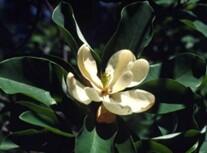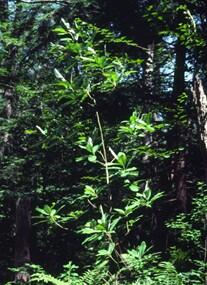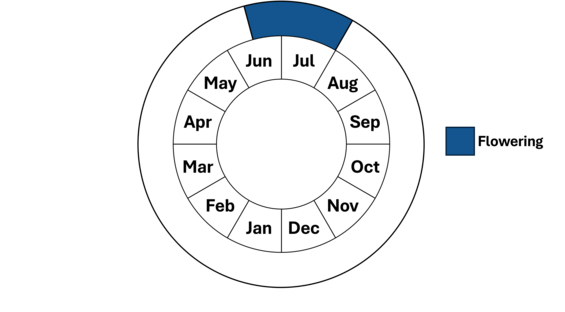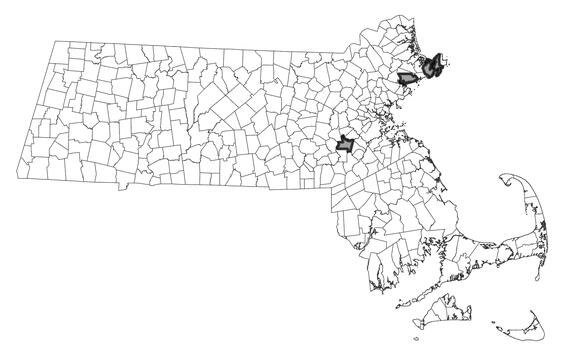- Scientific name: Magnolia virginiana
- Species of Greatest Conservation Need (MA State Wildlife Action Plan)
- Endangered(MA Endangered Species Act)
Description

Sweet Bay (Magnolia virginiana). Photo by Bruce Sorrie.
In Massachusetts, sweet bay is a deciduous, multi-trunked tall shrub or small tree to 10 m (33 ft) in height. In the South, sweet bay may reach 20 m (66 ft) and is often evergreen or semi-evergreen. In late spring to early summer sweet bay bears intensely fragrant flowers consisting of 9-12 white petals that are 3-5 cm (1-2 in) long. The seeds are borne inside fleshy red arils produced by an ellipsoid to round cone-like structure 2-5.5 cm (1-2 in) long by 1.5-3 cm (0.6-1.2 in) wide.
Sweet bay leaves are alternately arranged, oblong or ovate in shape 6 to 22 cm (2-9 in) long, with a leathery texture. The lower leaf surface is usually densely silky-pubescent (often appearing chalky white), above the leaves are dull to lustrous green. Leaves and twigs of this species are fragrant when broken.
Sweet bay is the only native or naturalized magnolia with a shrub-like habit and leathery leaves. Umbrella magnolia (Magnolia tripetala) and cucumber-tree (Magnolia acuminata) are naturalized in Massachusetts, but are taller species with larger non-leathery leaves.

Sweet Bay Shrub-like growth in Massachusetts. Photo by Bruce Sorrie.
Life cycle and behavior
This is an evergreen species.

Population status
Sweet bay is listed under the Massachusetts Endangered Species Act as endangered. All listed species are protected from killing, collecting, possessing, or sale and from activities that would destroy habitat and thus directly or indirectly cause mortality or disrupt critical behaviors. The Massachusetts Natural Heritage & Endangered Species Program has 5 records from 2 counties: Essex and Norfolk. Four of these records have been observed within the last 25 years.
Distribution and abundance
Sweet bay is found over much of the coastal plain and portions of the adjacent piedmont from Massachusetts to Texas. It is imperiled or critically imperiled in New York, Pennsylvania, and Tennessee. Sweet bay was only found in Essex and Norfolk Counties from 1983 to 2010.

Distribution in Massachusetts. 1999-2024. Based on records in the Natural Heritage Database.
Habitat
In Massachusetts, sweet bay is found in red maple swamps on the coastal plain. Associated canopy species include red maple (Acer rubrum), white pine (Pinus strobus), hemlock (Tsuga canadensis), black gum (Nyssa sylvatica), and yellow birch (Betula alleghaniensis). Associated shrub species include sweet pepper-bush (Clethra alnifolia) and highbush blueberry (Vaccinium corymbosum). Associated vines may include poison ivy (Toxicodendron radicans) and round-leaved greenbrier (Smilax rotundifolia). Associated herbaceous species may include New England aster (Symphyotrichum novae-angliae), jewelweed (Impatiens capensis), skunk cabbage (Symplocarpus foetidus), and cinnamon fern (Osmunda cinnamomea). Sphagnum moss (Sphagnum spp.) may also be present.
Healthy habitats are vital for supporting native wildlife and plants. Explore habitats and learn about conservation and restoration in Massachusetts.
Threats
Primary threats include any activities that alter the natural hydrology or water quality of its habitat and browsing by white-tailed deer. Invasive species, including Japanese barberry (Berberis thunbergii), glossy buckthorn (Frangula alnus), and purple loosestrife (Lythrum salicaria) may outcompete sweet bay plants, including seedlings.
Conservation
Sites should be monitored for the establishment and/or expansion of invasive plants. If control is deemed necessary, a plan should be developed, in consultation with the MassWildlife’s Natural Heritage and Endangered Species Program, to remove the invaders. However, in some cases, native species may also shade out sweet bay, so any management plan should address native species management if necessary.
Sites should also be monitored for deer browse and, if necessary, specific measures such as fencing used to maintain stable populations of sweet bay.
All active management of rare plant populations (including invasive species removal) is subject to review under the Massachusetts Endangered Species Act, and should be planned in close consultation with the Massachusetts Natural Heritage and Endangered Species Program.
References
Meyer, F.G. 1997. Magnolia. In: Flora of North America Editorial Committee, eds. 1993. Flora of North America North of Mexico. 15+ vols. New York and Oxford. Vol.3, p 8.
Rhoads, A. F., and T. A. Block. 2000. The Plants of Pennsylvania: an illustrated manual. University of Pennsylvania Press, Philadelphia, PA.
Contact
| Date published: | May 8, 2025 |
|---|